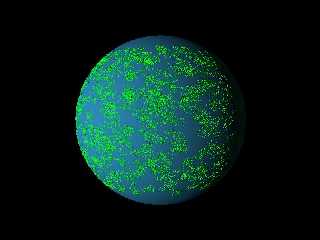 |
 |
|
 |
|
 |
|  |
|  |
|
 |
|
 |
|  |
|  |
|
 |
Attached is my first round at adding bumps to a planet object. It takes
about 3 minutes to render.
PROBLEM:
Using the rand(X) function in POV, I find that it creates too even a
distribution in the placement of all the objects in the picture. Notice
that the band of green bumps are fairly evenly spaced around the globe.
Does anyone have a better rand function that will get me better clumps of
land mass???
Robert J Becraft
aka cas### [at] aol com com
Post a reply to this message
Attachments:
Download 'Planets.jpg' (65 KB)
Preview of image 'Planets.jpg'

|
 |
|  |
|  |
|
 |
|
 |
|  |
|  |
|
 |
In article <386cbaca@news.povray.org>, "Robert J Becraft"
<cas### [at] aol com> wrote:
> Attached is my first round at adding bumps to a planet object. It takes
> about 3 minutes to render.
>
> PROBLEM:
>
> Using the rand(X) function in POV, I find that it creates too even a
> distribution in the placement of all the objects in the picture. Notice
> that the band of green bumps are fairly evenly spaced around the globe.
Interesting, looks like a lot of little islands...
Did you cover the sphere with a lot of randomly positioned bump-spheres
to get this? How much memory did it take?
> Does anyone have a better rand function that will get me better clumps of
> land mass???
Sounds like you want the noise3d() function or my eval_pattern()
function, both of which require a patch(so they can't be used with the
official POV), and neither of which have been incorporated into MegaPOV
yet. Well, noise3d() can be used in an isosurface function, but not
anywhere else, I wrote a little patch which allows it to be used
anywhere, it is that patch I am talking about.
Sorry, I don't know any way to accomplish this without using a patched
version.
--
Chris Huff
e-mail: chr### [at] yahoo com> wrote:
> Attached is my first round at adding bumps to a planet object. It takes
> about 3 minutes to render.
>
> PROBLEM:
>
> Using the rand(X) function in POV, I find that it creates too even a
> distribution in the placement of all the objects in the picture. Notice
> that the band of green bumps are fairly evenly spaced around the globe.
Interesting, looks like a lot of little islands...
Did you cover the sphere with a lot of randomly positioned bump-spheres
to get this? How much memory did it take?
> Does anyone have a better rand function that will get me better clumps of
> land mass???
Sounds like you want the noise3d() function or my eval_pattern()
function, both of which require a patch(so they can't be used with the
official POV), and neither of which have been incorporated into MegaPOV
yet. Well, noise3d() can be used in an isosurface function, but not
anywhere else, I wrote a little patch which allows it to be used
anywhere, it is that patch I am talking about.
Sorry, I don't know any way to accomplish this without using a patched
version.
--
Chris Huff
e-mail: chr### [at] yahoo com
Web page: http://chrishuff.dhs.org/ com
Web page: http://chrishuff.dhs.org/
Post a reply to this message
|
 |
|  |
|  |
|
 |
|
 |
|  |
|  |
|
 |
>>Interesting, looks like a lot of little islands...
>>Did you cover the sphere with a lot of randomly positioned bump-spheres
>>to get this? How much memory did it take?
They are small 8 triangle heightfields.
NW--- N ---- NE
| \ | / |
W ---- * ----- E
| / | \ |
SW--- S ---- SE
They vary in size randomly by how far out each of the nodes
NW/N/NE/W/E/SW/S/SE are from the peak at "*". The peak of each one is
randomly decided as well.
The problem is the placement on the globe... using the rand function, they
are getting placed too regularly, thus covering the entire globe... I want a
rand function that will give me more clustering across the globe.
I've tried a couple of different placement algorithms, but they are defeated
by the regular placement... for example, if I use one that places the
heightfields in smaller clusters that are box shaped around the globe, you
get box shapes instead of random clusters. This example uses very small box
clusters placed all over the globe from +X 45 degrees to -X 45 degrees.
???????
Robert J Becraft
aka cas### [at] aol com com
Post a reply to this message
|
 |
|  |
|  |
|
 |
|
 |
|  |
|  |
|
 |
Sounds like a job for a Perlin noise function. I can send you a 1D Perlin noise
macro (i.e. it generates floats in a fractal noise pattern). I haven't figured
out how to make it work in more dimensions. If you think it still might be
useful, give me a shout.
Margus
Robert J Becraft wrote:
>
> Attached is my first round at adding bumps to a planet object. It takes
> about 3 minutes to render.
>
> PROBLEM:
>
> Using the rand(X) function in POV, I find that it creates too even a
> distribution in the placement of all the objects in the picture. Notice
> that the band of green bumps are fairly evenly spaced around the globe.
>
> Does anyone have a better rand function that will get me better clumps of
> land mass???
>
> Robert J Becraft
> aka cas### [at] aol com
>
> [Image] com
>
> [Image]
Post a reply to this message
|
 |
|  |
|  |
|
 |
|
 |
|  |




![]()